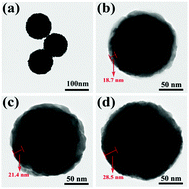Extraction of phenylurea herbicides from rice and environmental water utilizing MIL-100(Fe)-functionalized magnetic adsorbents†
Abstract
In this paper, a novel method is reported for the extraction and enrichment of phenylurea herbicides (PUHs) from rice and environmental water samples using MIL-100(Fe)-functionalized magnetic nanoparticles as adsorbents. Fe3O4@MIL-100(Fe) magnetic nanoparticles (MNPs) were prepared via self-assembly of MIL-100(Fe) NPs on the Fe3O4 surface modified by thioglycolic acid. The prepared Fe3O4@MIL-100(Fe) NPs displayed porosity, a conjugated structure and strong hydrogen bonding ability, which promoted high adsorption toward PUHs. We also showed that Fe3O4@MIL-100(Fe) NPs could adsorb and extract PUHs from environmental water and rice samples. After desorption using acetonitrile, PUH concentration was determined by a high performance liquid chromatography-diode array detector (HPLC-DAD). The limits of detection (S/N = 3) were 0.037–0.166 ng mL−1 in environmental water samples and 0.127–0.254 ng g−1 in rice samples. The determination coefficients (R2) were in the range of 0.9986–0.9993. The results indicate that the synthesized Fe3O4@MIL-100 (Fe) NPs are stable and effective adsorbents for the magnetic solid phase extraction (MSPE) of PUHs.



 Please wait while we load your content...
Please wait while we load your content...